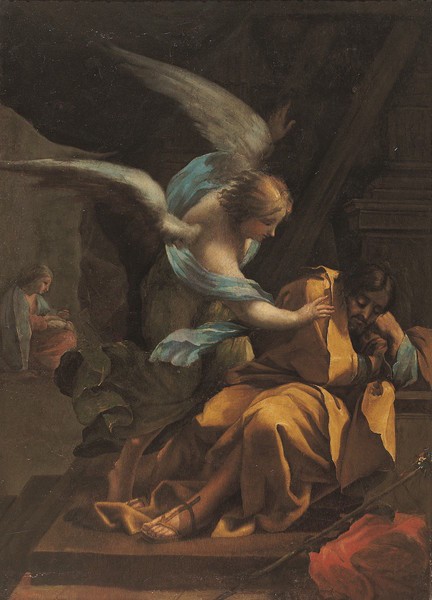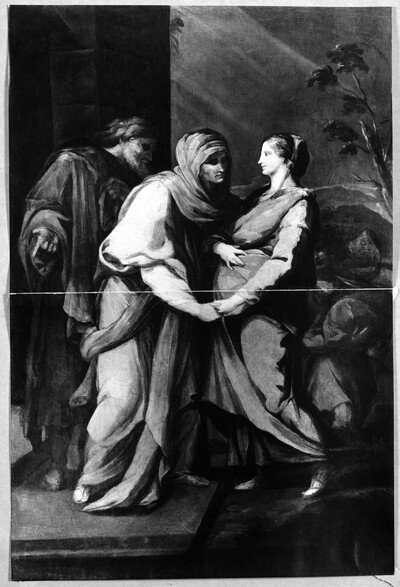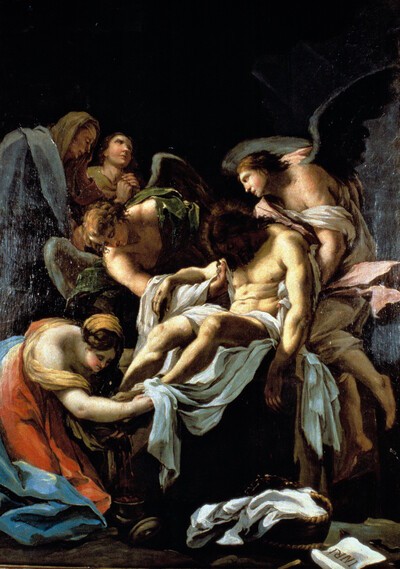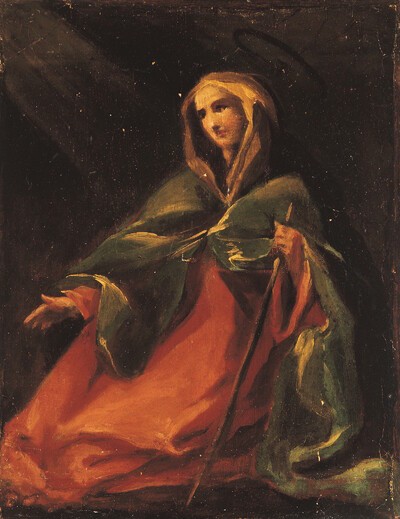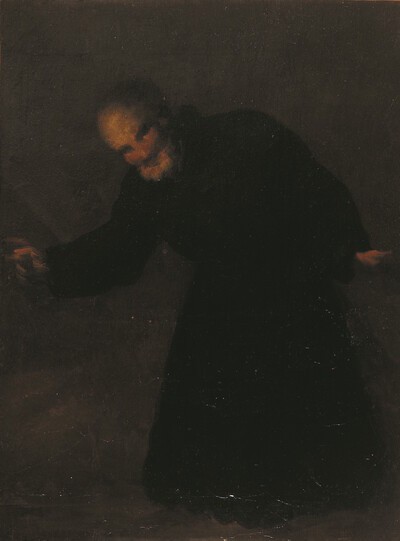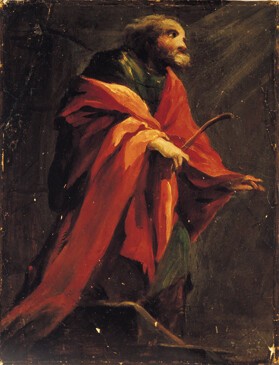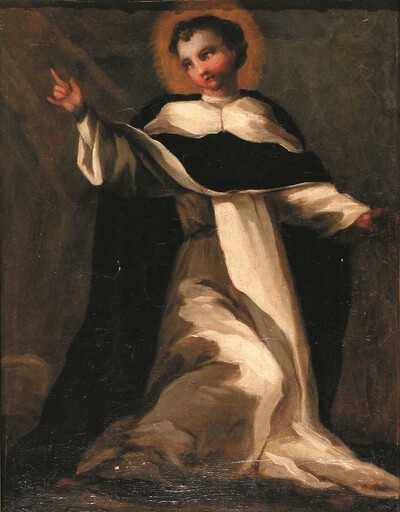- Cronología
- Ca. 1771 - 1773
- Ubicación
- Museum of Zaragoza, Zaragoza, Spain
- Dimensiones
- 128 x 93 cm
- Técnica y soporte
- Oil mural painting transferred to canvas
- Reconocimiento de la autoría de Goya
- Documented work
- Titular
- Government of Aragon
- Ficha: realización/revisión
- 05 Oct 2010 / 11 Dec 2024
- Inventario
- (09260)
This painting formed part of a set commissioned by Joaquín Cayetano Cavero Ahones y Pueyo de la Sierra (1735-1788), the Count of Sobradiel, to decorate the walls and ceiling of the oratory of his palace in Zaragoza, a building located in plaza de la Justicia which now houses the Illustrious Association of Notaries of Aragón.
Some time before 1926, the painting was lifted from the wall and transferred to canvas on the orders of Joaquín Cavero Sichar, Count of Gabarda. After his death, the Countess deposited the painting in the Provincial Museum of Zaragoza in 1929. Although it was acquired in 1930 by the Cuban Carlos Francisco Javier del Valle Grao, it remained in the museum's collection due to its poor state of conservation. In 1965 it was bought by the museum for 200,000 pesetas thanks to public subscription and various fundraising activities. It was restored twice (in 1966 and 1974) and definitively became part of the collection on 13 March 1976.
From December 5th, 2024, and while the Zaragoza Museum remains closed for works, the painting is part of the exhibition 'Goya. From the Museum to the Palace' in the Aljafería Palace in Zaragoza.
According to a written description by Ricardo del Arco (1915), this painting was located on the right-hand wall of the oratory opposite Visitation (La Visitación), and had already suffered serious damage in its original location due to a crack in the wall.
The subject corresponds with the events narrated in the Gospel of Saint Matthew (1:20). Saint Joseph is shown sitting on a step and leaning on a pedestal, wrapped in a yellow blanket. A young angel speaks to him as he sleeps. Some architectural elements are visible in the middle ground of the room where the scene takes place. In the lower right-hand corner of the foreground we can see the flowering staff and a red cloak, while the Virgin Mary is depicted in a sitting position in the background on the left.
The scene is composed using visibly rigid parallel diagonal lines, repeating with slight variations the model created by the French painter Simon Vouet (1590-1649) for a lost work produced around 1638 in oil on wooden panel. That painting formed part of the decoration of the Chapel d'Hachères in the Church of the Feuillants in rue Saint-Honoré in Paris: Goya had the opportunity to observe it in the form of a print version produced by Michel Dorigny.
The work underwent restoration work in 1966 at the Institute of Conservation and Restoration of Cultural Property in Madrid and subsequently in 1974.
-
Exposición de obras de Goya y de objetos que recuerdan las manufacturas artísticas de su épocaMuseo de ZaragozaZaragoza1928organized by la Real Academia de Nobles y Bellas Artes de San Luis in collaboration with the Junta del Patronato del Museo Provincial. April 1928núm. 6-8, 10,12,13
-
Realidad e imagen. Goya 1746 – 1828Museo de ZaragozaZaragoza1996consultant editor Federico Torralba Soriano. From October 3th to December 1st 1996cat.8
-
Goya y el Palacio de SobradielMuseo de ZaragozaZaragoza2006organized by Gobierno de Aragón at the Museo de Zaragoza, consultant editor Juan Carlos Lozano López. From December 15th 2006 to February 4th 2007cat. 10
-
Goya e ItaliaMuseo de ZaragozaZaragoza2008organized by the Fundación Goya en Aragóna, consultant editor Joan Sureda Pons. From June 1st to September 15th 2008cat. 198
-
Goya. From the Museum to the PalaceZaragoza2024cat.85
-
Pinturas de Goya (inéditas) en el palacio de los condes de Sobradiel de ZaragozaBoletín de la Sociedad Española de Excursiones1915pp.124-131
-
“Anotaciones al Goya joven”Paragone1954pp. 5-28
-
Vie et ouvre de Francisco de GoyaParísOffice du livre1970pp. 81, cat. 10
-
BarcelonaPolígrafa1970vol. I, p. 238, cat. 17
-
Goya en AragónEditorial Everest1970p. 20
-
Goya en ZaragozaZaragozaAyuntamiento de Zaragoza1971pp. 37-46
-
Datos inéditos y precisiones iconográficas y estilísticas sobre las pinturas que decoraban el oratorio del palacio de los condes de Sobradiel en Zaragoza, originales de Francisco de GoyaArchivo Español de Arte1990pp. 59-67
-
Goya. Pintor religiosoDiputación General de Aragón1990pp. 70 y ss.
-
Goya y Aragón. Familia, amistades y encargos artísticoscol. Col. Mariano de Pano y RuataZaragozaCaja de Ahorros de la Inmaculada de Aragón1995pp. 94-98
-
Realidad e imagen. Goya 1746 – 1828MadridGobierno de Aragón y Electa España1996pp. 60-61
-
Goya y el Palacio de SobradielZaragozaGobierno de Aragón, Dpto. de Educación, Cultura y Deporte2008p. 232
-
Goya e Italia, 2 vols.ZaragozaFundación Goya en Aragón y Turner2008vol. II, pp.126
-
Goya y Zaragoza (1746-1775). Sus raíces aragonesasZaragozaFundación Goya en Aragón, Ibercaja y Gobierno de Aragón2015pp. 63-66
-
Goya. From the Museum to the PalaceZaragozaZitro Comunicación2024pp.84-85
